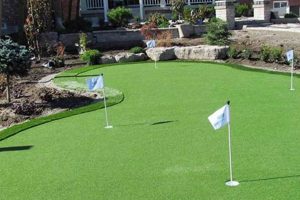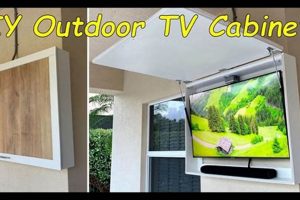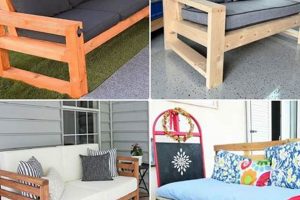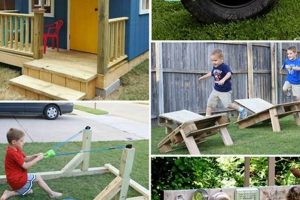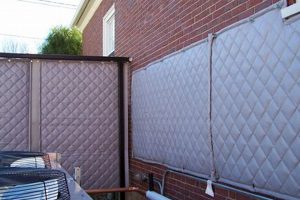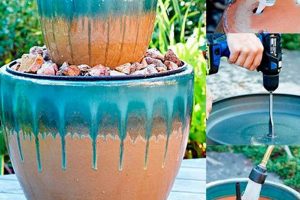A do-it-yourself exterior sofa represents a seating arrangement constructed from readily available materials by an individual, rather than purchased pre-assembled. For instance, discarded shipping pallets, repurposed lumber, or concrete blocks can be combined with cushions and fabric to form a customized outdoor seating solution.
The appeal of creating such furnishings lies in cost-effectiveness, personalization, and environmental consciousness. Building one’s own exterior seating can significantly reduce expenses compared to retail prices. Furthermore, it allows for complete customization in terms of size, style, and material selection, ensuring that the finished product perfectly complements the surrounding outdoor space. Historically, self-sufficiency in furniture construction has reflected a desire for independence and resourcefulness, often driven by economic necessity or a preference for handcrafted items.
This discussion will delve into various material options, design considerations, construction techniques, and finishing touches involved in creating durable and aesthetically pleasing outdoor seating. Practical tips and step-by-step guidance will be offered to facilitate the successful completion of such a project.
Essential Considerations for Outdoor Seating Construction
The following recommendations aim to optimize the longevity, comfort, and aesthetic appeal of self-constructed exterior sofas. Adherence to these guidelines can mitigate common pitfalls associated with DIY projects.
Tip 1: Material Selection is Paramount: Employ weather-resistant materials such as treated lumber, cedar, redwood, or recycled plastic lumber to combat moisture damage, insect infestation, and rot. Avoid untreated softwoods that are prone to deterioration.
Tip 2: Prioritize Structural Integrity: Reinforce joints with screws, bolts, and exterior-grade wood glue to ensure stability and prevent premature failure. Corner bracing and internal supports are crucial for withstanding weight and stress.
Tip 3: Incorporate Adequate Drainage: Design the seating to facilitate water runoff. Slatted surfaces or slightly angled seat cushions prevent water accumulation, minimizing the risk of mold and mildew growth.
Tip 4: Cushion and Fabric Choice are Critical: Opt for outdoor-rated cushions and fabrics that are UV-resistant, water-repellent, and fade-resistant. Consider mildew-resistant fillings to further enhance durability.
Tip 5: Apply Protective Finishes: Seal or stain the wood with a weather-resistant finish to protect it from the elements. Regular reapplication is essential to maintain the protective barrier.
Tip 6: Consider Ergonomics: Design the seating with comfortable dimensions in mind. Seat height, back angle, and armrest placement should promote relaxation and proper posture.
Tip 7: Secure the Seating: If the seating is situated in a windy area, consider anchoring it to the ground or a solid structure to prevent it from being blown over.
By carefully considering these elements, the resulting exterior seating will offer both enduring functionality and aesthetic value. Attention to detail during the planning and construction phases will significantly enhance the lifespan of the furniture.
The subsequent sections will explore various design styles and offer step-by-step instructions for constructing specific models.
1. Material durability
The durability of materials selected for a do-it-yourself outdoor sofa directly dictates its lifespan and resistance to environmental degradation. The selection of inappropriate materials can lead to premature failure, rendering the construction effort and associated expenses unproductive. The cause-and-effect relationship is straightforward: exposure to moisture, sunlight, temperature fluctuations, and biological agents (insects, fungi) will compromise the structural integrity of susceptible materials, leading to warping, cracking, rotting, or disintegration. The importance of material durability is therefore paramount in ensuring the longevity and functionality of the seating.
Consider, for example, a sofa constructed from untreated pine in a humid climate. Without protective measures, the wood will rapidly absorb moisture, creating an environment conducive to fungal growth and insect infestation. This will result in structural weakening, necessitating costly repairs or complete replacement within a short timeframe. Conversely, using naturally rot-resistant wood like cedar or redwood, or employing treated lumber, provides a significantly extended service life. Similarly, outdoor fabrics must resist fading and degradation from ultraviolet radiation and repeated exposure to moisture; failure to select UV-resistant fabrics leads to rapid discoloration and weakening of the material. The practical significance lies in minimizing long-term maintenance costs and ensuring the continued usability and aesthetic appeal of the exterior seating.
In summary, the selection of durable materials is an indispensable element of successful do-it-yourself outdoor sofa construction. While initial cost considerations may tempt the use of less expensive, non-durable options, the long-term implications of material failure far outweigh any short-term savings. A thorough understanding of material properties and their resistance to environmental stressors is crucial for achieving a durable and sustainable outcome. Addressing the challenge of material selection proactively mitigates potential structural issues and enhances the overall value and lifespan of the outdoor seating.
2. Structural Integrity
Structural integrity is a paramount consideration in the design and construction of any do-it-yourself outdoor sofa. The sofa’s capacity to withstand applied loads, environmental stressors, and prolonged use is directly dependent on the robustness of its structural design and the quality of its construction.
- Joint Strength
The strength of the joints connecting the various components of the sofa is critical. Weak or poorly constructed joints are prone to failure under stress, leading to instability and potential collapse. Proper jointing techniques, such as mortise and tenon, dovetail, or the use of screws and bolts with appropriate adhesive, are essential for ensuring robust connections. Consider a scenario where a sofa utilizes butt joints held together solely with nails. Under repeated use, these joints will likely loosen, resulting in a wobbly and ultimately unusable piece of furniture. Conversely, properly executed mortise and tenon joints will provide significantly greater strength and stability.
- Material Selection and Load-Bearing Capacity
The inherent strength of the materials used in the construction of the sofa must be sufficient to bear the anticipated loads. Softwoods like pine may be suitable for purely decorative elements, but load-bearing components, such as the frame, require stronger materials like treated lumber, hardwoods, or metal. An under-engineered frame constructed from insufficient materials will deform or break under load, compromising the entire structure. The load-bearing capacity must be carefully calculated and factored into the material selection process.
- Support and Reinforcement
Adequate support and reinforcement are crucial for preventing sagging, warping, and other forms of deformation. Internal bracing, corner supports, and strategically placed cross-members can significantly enhance the structural integrity of the sofa. A large, unsupported span in the seating area, for example, is prone to sagging over time. The addition of a central support beam or the incorporation of a webbing system can distribute the load more evenly and prevent deformation.
- Environmental Resistance
Structural integrity is also affected by the sofa’s ability to withstand environmental stressors, such as moisture, temperature fluctuations, and UV radiation. The use of weather-resistant materials and protective finishes is essential for preventing degradation and maintaining structural soundness. Untreated wood exposed to moisture will rot, weakening the structure and ultimately leading to failure. Protective coatings, such as sealants and stains, can mitigate these effects and extend the lifespan of the sofa.
In conclusion, the structural integrity of a do-it-yourself outdoor sofa is a multifaceted consideration encompassing joint strength, material selection, support systems, and environmental resistance. A holistic approach to these elements is essential for creating a durable, safe, and long-lasting piece of outdoor furniture.
3. Weather resistance
Weather resistance is an indispensable attribute of any do-it-yourself outdoor sofa, directly influencing its longevity, structural integrity, and aesthetic appeal. The ability to withstand environmental elements such as moisture, sunlight, and temperature fluctuations is critical for ensuring the sofa’s sustained performance and minimizing maintenance requirements. Failure to address weather resistance adequately will result in premature degradation and functional impairment.
- Material Selection and Water Resistance
The inherent water resistance of the materials employed in the construction of the sofa is paramount. Materials such as untreated wood are highly susceptible to moisture absorption, leading to swelling, warping, and eventual rot. Conversely, materials like treated lumber, cedar, redwood, and certain plastics exhibit superior resistance to water penetration, thus mitigating the risk of water damage. For example, using pressure-treated lumber for the frame and support structure of the sofa provides a robust barrier against moisture, whereas untreated pine would quickly deteriorate under similar conditions.
- UV Radiation Protection
Prolonged exposure to ultraviolet (UV) radiation from sunlight can cause significant degradation of both structural materials and upholstery fabrics. Wood can become brittle and discolored, while fabrics can fade and lose their strength. Incorporating UV-resistant finishes, such as stains or sealants with UV inhibitors, and selecting UV-resistant fabrics are essential for protecting the sofa from the damaging effects of sunlight. An outdoor sofa using standard indoor fabric will experience accelerated fading and material breakdown compared to one using specialized outdoor-rated fabric.
- Drainage and Ventilation Considerations
Proper drainage and ventilation are critical for preventing the accumulation of moisture, which can promote mold and mildew growth. Design features that facilitate water runoff and allow for air circulation can significantly reduce the risk of moisture-related damage. For instance, incorporating slatted seating surfaces and ensuring adequate spacing between components promotes airflow and prevents water from pooling. A tightly sealed sofa construction, conversely, traps moisture and creates a favorable environment for microbial growth.
- Protective Finishes and Sealants
The application of protective finishes and sealants provides an additional layer of defense against the elements. These coatings create a barrier that repels water, blocks UV radiation, and inhibits the growth of mold and mildew. Regular maintenance, including periodic reapplication of these finishes, is necessary to maintain their effectiveness. A sofa treated with a high-quality outdoor sealant will exhibit significantly greater resistance to weathering than an untreated sofa.
In conclusion, weather resistance is a multifaceted attribute that necessitates careful consideration of material selection, design features, and protective finishes. By proactively addressing these factors, the longevity, functionality, and aesthetic appeal of a do-it-yourself outdoor sofa can be significantly enhanced. Neglecting weather resistance will inevitably result in premature degradation, increased maintenance costs, and a diminished overall lifespan for the seating.
4. Design Aesthetics
The incorporation of design aesthetics into the do-it-yourself outdoor sofa project directly influences its integration within the existing outdoor environment and its perceived value. Aesthetic considerations extend beyond mere visual appeal; they encompass the sofa’s form, proportion, color palette, and textural qualities, all of which contribute to its overall harmony with the surrounding landscape and architectural style. A failure to prioritize design aesthetics can result in a finished product that appears incongruous or detracts from the visual coherence of the outdoor space. For example, a rustic-style sofa constructed from unfinished pallets might complement a natural, informal garden setting, whereas the same design would be jarring in a modern, minimalist patio.
The impact of design aesthetics extends to the perceived comfort and usability of the outdoor sofa. A well-designed sofa invites relaxation and social interaction, while a poorly designed one may discourage use. The choice of materials, cushion styles, and overall form can either enhance or detract from the user experience. An example of practical application lies in selecting a color palette that complements the natural environment, opting for earth tones or muted shades that blend seamlessly with the surrounding foliage and landscape features. Thoughtful consideration of proportion, ensuring the sofa’s scale is appropriate for the available space, further enhances its visual appeal and functional utility.
In summary, design aesthetics are not merely superficial embellishments but rather integral components of a successful do-it-yourself outdoor sofa project. The careful consideration of form, proportion, color, and texture, coupled with an understanding of the surrounding environment, enhances the sofa’s visual appeal, promotes usability, and ultimately contributes to its perceived value. Overlooking design aesthetics can lead to a visually discordant outcome, while prioritizing them ensures the sofa seamlessly integrates into its outdoor setting, enhancing both its functionality and its aesthetic contribution to the space.
5. Ergonomic comfort
Ergonomic comfort represents a critical design consideration in the construction of a do-it-yourself outdoor sofa, directly influencing its usability and user satisfaction. A sofa lacking ergonomic design principles may result in discomfort, strain, and ultimately, infrequent use. The cause-and-effect relationship is evident: inadequate seat height, insufficient back support, or poorly positioned armrests can lead to postural problems, muscle fatigue, and discomfort during prolonged sitting. Therefore, ergonomic comfort is an essential component that directly affects the practicality and enjoyment derived from the seating. For example, a sofa with a seat depth that is too long may not provide adequate back support for shorter individuals, while a sofa with a backrest that is too low may not offer sufficient spinal support for anyone. The practical significance lies in ensuring the sofa is conducive to comfortable and prolonged use, enhancing its value and utility as an outdoor relaxation space.
The application of ergonomic principles to DIY outdoor sofas involves several key considerations. Seat height should be appropriate for the average user, typically ranging from 16 to 18 inches, to allow for comfortable foot placement on the ground. Backrest angle should provide adequate lumbar support, ideally between 100 and 110 degrees, promoting proper spinal alignment. Armrests should be positioned at a comfortable height, typically around 8 to 10 inches above the seat, to reduce strain on the shoulders and neck. Furthermore, the selection of appropriate cushion density and fabric texture contributes to overall comfort. For example, a firm cushion may provide better support for some individuals, while a softer cushion may be preferred by others. Similarly, a breathable fabric is essential for preventing overheating and discomfort in warm weather. The implementation of these considerations allows for the creation of an outdoor sofa that is not only aesthetically pleasing but also ergonomically sound.
In summary, ergonomic comfort is a non-negotiable aspect of do-it-yourself outdoor sofa design. Addressing aspects such as seat height, back support, armrest placement, and cushion selection is crucial for ensuring a comfortable and enjoyable seating experience. While aesthetic considerations are important, prioritizing ergonomic design principles is essential for maximizing the usability and long-term value of the outdoor sofa. Neglecting these considerations can result in an aesthetically pleasing but ultimately uncomfortable piece of furniture, diminishing its practicality and appeal.
6. Cost-effectiveness
Cost-effectiveness is a primary motivator for undertaking a do-it-yourself outdoor sofa project. The financial expenditure associated with purchasing pre-assembled outdoor furniture often exceeds the cost of materials required for self-construction. This disparity in cost stems from factors such as manufacturing overhead, retail markup, and branding expenses inherent in commercial furniture production. Consequently, constructing a sofa independently presents a viable avenue for reducing overall expenditure. A significant cause-and-effect relationship exists: lower material costs, coupled with the elimination of labor charges, directly result in a more economical final product.
The degree of cost savings is contingent on several variables, including the choice of materials, the complexity of the design, and the availability of repurposed resources. Utilizing reclaimed lumber or recycled materials can further diminish the overall cost. For example, a sofa frame constructed from repurposed shipping pallets, combined with purchased cushions and fabric, represents a substantially lower investment compared to a comparable retail sofa. Practical application involves meticulous budgeting and material sourcing to optimize cost-effectiveness without compromising structural integrity or aesthetic appeal. The importance of cost-effectiveness extends beyond immediate savings; it also allows for the allocation of resources towards higher-quality materials or customized features that would be financially prohibitive in a retail setting.
In summary, cost-effectiveness serves as a compelling rationale for pursuing a do-it-yourself approach to outdoor sofa construction. The potential for significant cost savings, coupled with the opportunity for customization and resourcefulness, underscores the practicality of this endeavor. Challenges may arise in balancing cost considerations with the desire for durability and aesthetic quality. Ultimately, a thorough understanding of material costs, design principles, and construction techniques is essential for maximizing cost-effectiveness and achieving a satisfactory outcome. The DIY outdoor sofa project provides a tangible example of how resourcefulness and skill can translate into substantial financial benefits.
Frequently Asked Questions About DIY Outdoor Couch Construction
The following addresses common inquiries and misconceptions regarding the planning and execution of self-constructed exterior seating projects. The information aims to provide clarity and guidance for individuals considering this endeavor.
Question 1: What is the anticipated lifespan of a do-it-yourself outdoor sofa?
The lifespan is contingent upon material selection, construction quality, and environmental exposure. Sofas constructed from weather-resistant materials, such as treated lumber or cedar, and assembled with robust joinery can last for several years with proper maintenance. Sofas constructed from less durable materials and assembled with inferior techniques will have a significantly shorter lifespan.
Question 2: Are specialized tools required for building an outdoor sofa?
The specific tools required depend on the design and construction methods employed. However, basic tools such as a saw, drill, measuring tape, and fasteners are generally necessary. More complex designs may necessitate specialized tools like a power sander or router. The availability of appropriate tools is a crucial factor in project planning.
Question 3: How can the cost of materials be minimized?
Cost reduction can be achieved through several strategies, including the utilization of reclaimed lumber, the selection of less expensive materials, and the optimization of material usage. Sourcing materials from salvage yards or online marketplaces can yield significant savings. Balancing cost considerations with durability requirements is essential.
Question 4: What are the essential safety precautions to observe during construction?
Safety precautions include wearing appropriate personal protective equipment (PPE), such as safety glasses and gloves, and adhering to safe tool handling practices. Working in a well-ventilated area and taking precautions to prevent injuries from cuts, splinters, and falls are also essential. Prioritizing safety mitigates the risk of accidents and injuries.
Question 5: How can the outdoor sofa be protected from the elements?
Protection from the elements can be achieved through the application of weather-resistant finishes, the use of protective covers during inclement weather, and the placement of the sofa in a sheltered location. Regular maintenance, including cleaning and re-application of finishes, is necessary to maintain protection over time.
Question 6: What are the common pitfalls to avoid when building an outdoor sofa?
Common pitfalls include inadequate planning, insufficient material strength, poor joint construction, and neglecting weather resistance. Thorough planning, the selection of appropriate materials, the use of robust joinery techniques, and the application of protective finishes are crucial for avoiding these pitfalls.
In summary, successful do-it-yourself outdoor sofa construction necessitates careful planning, the selection of appropriate materials, adherence to safe practices, and ongoing maintenance. Addressing these factors proactively enhances the likelihood of a satisfactory outcome.
The subsequent section will provide detailed instructions for constructing a specific outdoor sofa design.
Concluding Remarks on Exterior Seating Construction
This examination of constructing a do-it-yourself outdoor couch has underscored the multifaceted considerations inherent in such a project. Material durability, structural integrity, weather resistance, design aesthetics, ergonomic comfort, and cost-effectiveness have each been identified as critical factors influencing the success and longevity of the finished product. Careful attention to these elements is essential for ensuring a functional, aesthetically pleasing, and economically sound outcome.
The decision to undertake the construction of exterior seating represents a commitment to resourcefulness and personalized design. Successful implementation necessitates a thorough understanding of construction principles, material properties, and environmental factors. Prospective builders are encouraged to approach this endeavor with meticulous planning and a dedication to quality craftsmanship, thereby realizing the full potential of a custom-built outdoor furnishing. Consider these principles to create a suitable and durable “diy outdoor couch”.


